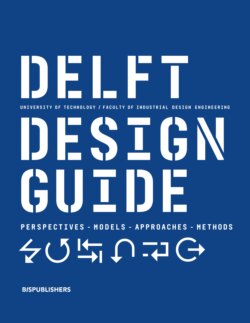Читать книгу Delft Design Guide -Revised edition - Annemiek van Boeijen - Страница 15
На сайте Литреса книга снята с продажи.
Оглавлениеand iteratively explore their potential in realising the desired change. They will keep asking how to realise maximum effect with minimum means for people and within the complex systems that we find ourselves in today.
The Delft Design Guide embodies a diverse and rich set of perspectives, models, approaches and methods that can help you in navigating uncertainty and realising your design goals. There is one major prerequisite: you need to take the steering wheel and always reflect on what ways of working are most likely to help you achieve your goals. In doing so, you need to reflect on both your own values and beliefs as well as the ones of the organisation and community you are working with or for. This means that there are three core questions to ask yourself continuously: 1. what do I want to achieve or contribute? 2. What is the best way to reach these goals? 3. Am I still on the best path to get where I need and want to be? In short: be reflective!
Be a co-creator and facilitator
Design is an integrative discipline. Designers work with clients, stakeholders in the organisation, external stakeholders, experts from other disciplines, users, et cetera. An important role of the perspectives, models, approaches and methods is to provide a common structure and language for innovation projects and practices that facilitate productive collaboration, trust and coordination amongst the diverse sets of people that are typically involved in design.
Be a navigator
A design assignment is typically framed along two dimensions: impact and manifestation . Impact refers to a desired effect of the design. M anifestation refers to the way the design manifests itself in the world, for instance, a physical product, a service, an app or a game. For both impact and manifestation, an assignment can either define what is expected, or leave it open for the designer. The position of an assignment in one of the quadrants gives direction to the kind of approach and/or methodology that is appropriate and likely to help you achieve your aims. Of course, the world is not as black and white as the matrix suggests, it should be used as a canvas. The more experienced you are as a designer, the more you know how to play with the model.
1. Impact fixed, manifestation fixed.
The classic design assignment: how the design should be manifested and what impact it should have is fixed. A good example is the assignment for a ticket vending machine for public transport. Both impact and manifestation are given from the start.
---------
For this kind of assignment, you can work with a user-centred design approach to structure the overall process. Various methods like interviews or focus groups can be used to elicit and validate specific user needs. The WWWWWH method can be used to generate relevant questions for the problem analysis and a list of requirements to capture and manage all requirements to inform solution development.
2. Impact open, manifestation fixed.
Assignments of this nature often focus on generating new business models or expanding current businesses. The manifestation in this case is often tied to the assets of the organisation, for instance, its current production facilities, technology expertise or distribution channels. A good example is TomTom, who became famous with its GPS navigation products. When smartphones were introduced, the company realised that selling hardware products to consumers would not be a sustainable business model anymore. Tom Tom successfully changed its strategy and moved from a business-to-consumer to a business-to- business approach, building on the available assets.
Navigation Canvas.
(Source: Jeroen van Erp)
manifestation OPEN
IMPACT
OPEN
FIXED
FIXED
1
3
2
4
